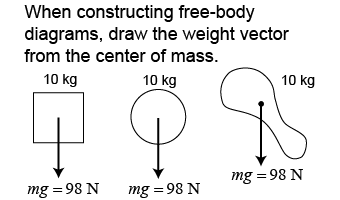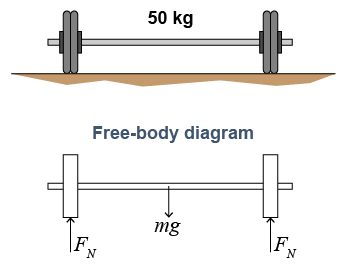|
 For rigid objects it is usually accurate to consider the weight force to act on an object’s center of mass. The center of mass is the average location of all the mass contained in the object. For a solid, simple-shaped object like a cube, the center of mass is the geometric center. In contrast, if the mass is unevenly distributed within an object or the object is irregularly shaped, then the center of mass might be at another point that is not the geometric center. In certain shapes, such as a ring, the center of mass lies completely outside the object.
For rigid objects it is usually accurate to consider the weight force to act on an object’s center of mass. The center of mass is the average location of all the mass contained in the object. For a solid, simple-shaped object like a cube, the center of mass is the geometric center. In contrast, if the mass is unevenly distributed within an object or the object is irregularly shaped, then the center of mass might be at another point that is not the geometric center. In certain shapes, such as a ring, the center of mass lies completely outside the object. 
|
You can find the center of mass of an irregular object by hanging it from a string. The center of mass will always lie directly below the line of the string. If you choose three different points, the intersection of the three lines (one for each string choice) shown in the diagram (above) locates the center of mass. 
|
 When constructing a free-body diagram, the weight force is drawn downward from the center of mass. The diagram on the right shows the force vector for weight drawn at the center of mass of the different 10 kg objects illustrated above.
When constructing a free-body diagram, the weight force is drawn downward from the center of mass. The diagram on the right shows the force vector for weight drawn at the center of mass of the different 10 kg objects illustrated above. 
|
 A barbell with a mass of 50 kg is resting on the floor. Draw a free-body diagram of the barbell and calculate its weight in newtons.
A barbell with a mass of 50 kg is resting on the floor. Draw a free-body diagram of the barbell and calculate its weight in newtons. | Asked: | Calculate weight and draw a free-body diagram. | | Given: | mass = 50 kg | | Relationships: | Fw = mg | | Solution: | The weight force is drawn at the center of mass, which is in the middle of the barbell.
Fw = mg
= (50 kg)(9.8 N/kg) = 490 N | | Answer: | 490 N | 
|

